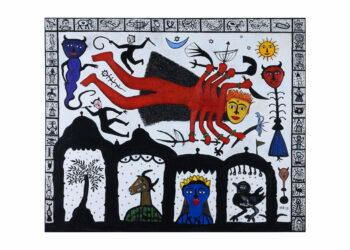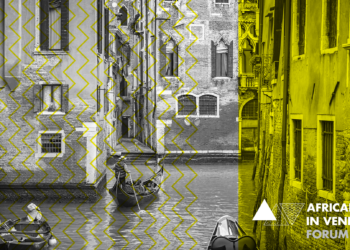The 7th Lubumbashi Biennale, postponed because of the coronavirus pandemic, opened on the 6th October 2022 in the Democratic Republic of Congo in its south-eastern city.
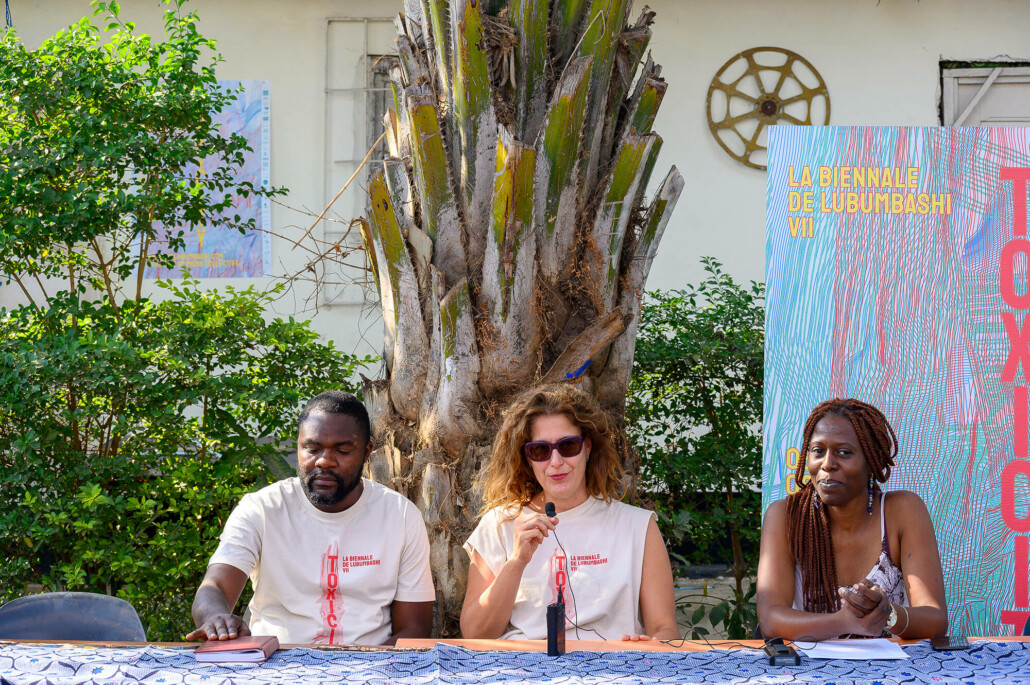
Opening of the Biennale at Picha with the artistic director of the Ateliers, Lucrezia Cippitelli and the two coordinators of the programme: Bibiche Tankama & Jackson Bukasa. © Arsène Mpiana
This was after a press conference held under the moderation of Costa Tshinzam, at Casa Mia (on 4 October of the same year) before a panel made up of: Alexandre Mulongo Finkelstein and Jean Katambayi Mukendi (members of Picha ASBL), Paula Nascimento and Bruno Leitão (associate curators) and Luigi Coppola and Godelive Kasangati (artists). To be seen until November 6th of this year, it is perceived by many observers as “a collective biennial that succeeds in its local rootedness in a city without an academy of fine arts like Lubumbashi”. But how was it organised?
Entitled “ToxiCité”, this biennial event showcases the creations of more than 60 artists from the Congo and its diaspora as well as from other African and international countries, such as Pamina Sebastiao and Francis Alys, on more than 10 sites, chosen out of the 7 municipalities that make up the city. Through their work, the artists encourage and enable us to look at “the two concepts of “toxic” and “city” or “town” both in their urban dimensions and as an effect of extractivism, and modern thinking based on the infinite growth of yields through the use of chemical substances.
Together with the French Institute of Lubumbashi (Halle de l’étoile), the Institute of Fine Arts, the National Museum of Lubumbashi and the Marcel Yabili Family Museum, the brand new Biasasa Art Centre, Picha, the Maison Wallonie Bruxelles Internationale, the M’zée Health Centre and the Contemporary Art Gallery (ASBL Dialogues), the City Hall hosted the works of artists Gulda El Magambo, Georges Senga and Nicole Rafiki. Hanging on the metal structure of the Town Hall enclosure, the photographs from Gulda El Magambo’s Kazi terremines series highlight the apparent contrast of the poor women who spend entire days “looking for happiness” in the lithium mines (an essential element in the manufacture of electric car batteries) in Manono, Tanganyika. These women, sometimes on board a Tesla, sometimes with the latest mobile phones, despite their state of poverty (reflected in their attire), clearly show the paradox of a “rich country with poor people”, even if it is well known that one shouldn’t “judge a book by its cover”. Georges Senga returned with his book project, which was published at the end of October in Rome and is entitled: How a little pagan hunter becomes a Catholic priest. On this occasion, he gave a pre-recorded and live reading of the letters that Bonaventure Salumu and Lucie Bode exchanged, a priest and a nun, who decided to leave the orders to live their love. Finally, Nicole Rafiki presents photographs printed on canvas from her series Mukalenge Mukaji (2022). This is perhaps a reminder of the important role that women played or still play in the transmission of power, the economy, the assurance of posterity, in short, the balance of the family, the tribe or the clan among the Luba of Kasai.
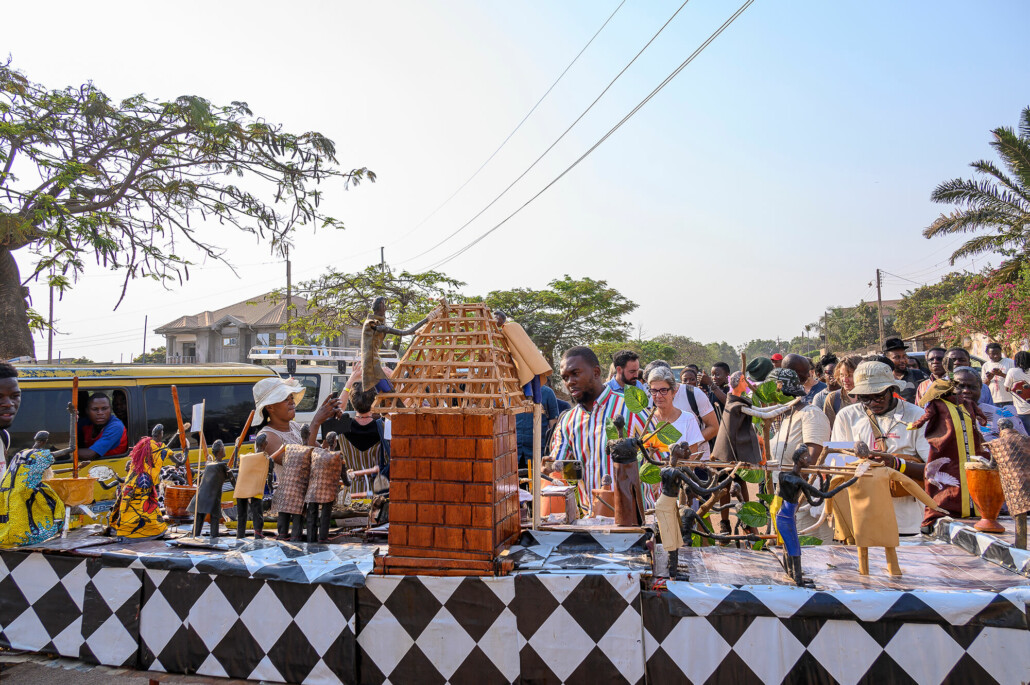
Justice Kasongo’s Congo: Traces, Evolution and Memories installation, Lubumbashi, 2022. © Arsène Mpiana
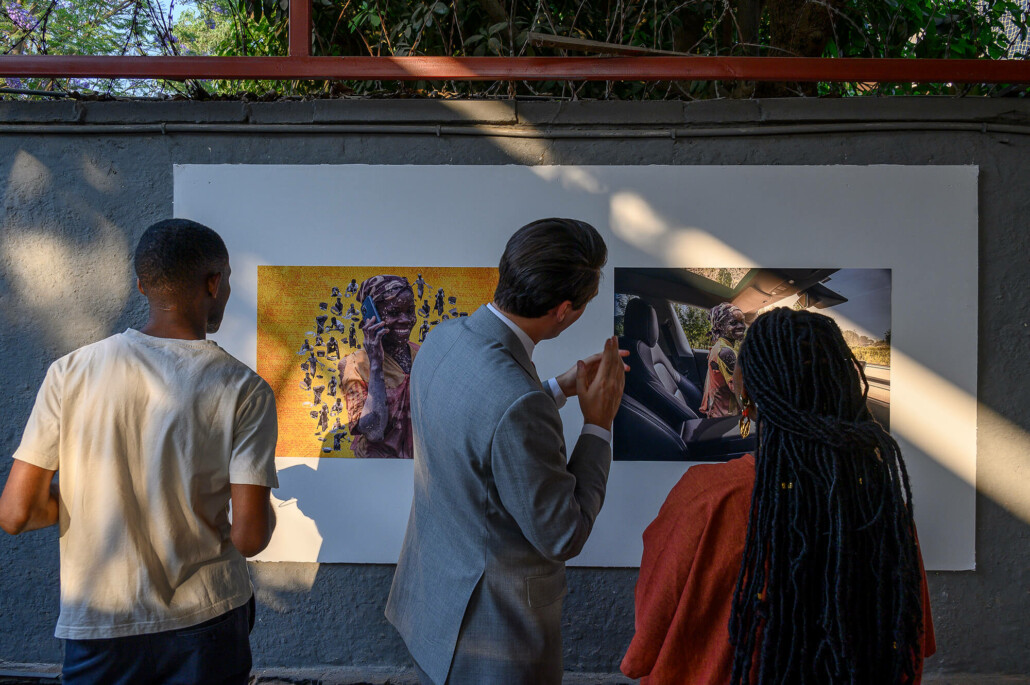
Two visitors in front of Pamela Tulizo’s Matrice photo series at Centre Wallonie-Bruxelles, Lubumbashi, 2022. © Arsène Mpiana
It should also be noted that this Biennial event benefited from the support of the people of Lubumbashi with the Mayor of the city, who, in addition to allowing Picha to use Lubumbashi as an exhibition space, personally made the trip to the National Museum of Lubumbashi to visit the exhibition and buy some of the artworks. A step that seems to reinforce the idea of a biennial that succeeds in its local rootedness in the wake of the work done in particular by Sandrine Colard and, before her, Toma Muteba Luntumbue.
For a population that is paradoxically used to cohabiting with toxicity, as was the case with the smoke from the large Gécamines chimney, which revived hopes for a better life, the problem of the damages inherent in mining is dealt with in the discursive programme “Les Palabres de la Biennale“. With “Ubatizo, la Genèse du Mal” (Ubatizo, the Genesis of Evil), a film in which director Fundi Mwamba Gustave Giresse shows, without gloves, cases of congenital malformations due to soil, water and air pollution in the fictional village of Lufwa, the artist plunges us into a “Toxi-cine” experience. In the same vein, “On Trade Off: The Time of the Shadow” invites us to look at the imminent exploitation of the lithium deposit (an essential element in the manufacture of electric batteries in a world that is making its energy transition) discovered in Manono. This raises the question of the equivocal relationship between the environment and the economy of a country that tends to pass from a “geological scandal” to the “curse of natural resources”, as mentioned by the provincial coordinator of the National Programme for the Fight against Drug Addiction and Toxic Substances of the Ministry of Public Health, Professor Banza Lubaba Nkulu, in “Mining and Health in Grand Katanga, DRC”.
With five associate curators – Paula Nascimento, Lucrezia Cipitelli, Bruno Leitão, René Francisco Rodríguez and Mpho Matsipa – and a curatorial advisor – Ugochukwu-Smooth C. Nzewi, this biennale will have been one of lasting collaborations, as is the case with the “star” work of this edition: the presentation of the comic strip inspired by the multi-awarded film by the directors Tetshim and Franck Mukunday with the collaboration of the author Alexandre Mulongo Finkelstein: “Machini“. Proof of the success of this local response: all the copies were snapped up like hotcakes!
Costa Tshinzam is a writer, blogger, and author who is a member of the Habari RDC community.
For more information, please visit the Lubumbashi Biennale.
